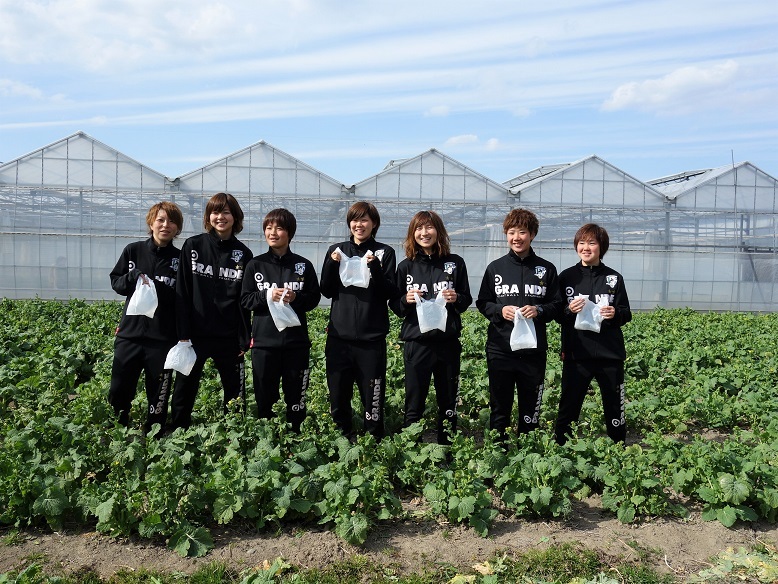元記事はコチラ ▶ 千葉県鴨川市【みんなみの里】で食用菜花摘み!春の味覚を楽しもう♪(Minnami no Sato in Kamogawa, Chiba Prefecture) : “Life in 東京” 日英バイリンガルブログ
前回に引き続き、一般社団法人プレスマンユニオンのご案内で千葉県鴨川市を取材した際のことをつづります。2日目(2月26日)に訪れた「みんなみの里〜鴨川市総合交流ターミナル〜」での食用菜花(ナバナ)摘みは、3月上旬までだそうなので、急ぎ書きたいと思います!
I visited Kamogawa City, Chiba Prefecture, on a press tour during the weekend of February 25-26. On the second day, we went to Minnami no Sato, where we got to handpick edible canola flowers. Please note that this activity is only available until the beginning of March — hence why I’ve made this blog entry now!
(What’s the difference between edible canola flowers and those that aren’t?)
前回レポートした「菜な畑ロード」では観賞用の菜の花を摘めましたが、ここ「みんなみの里」で体験できるのは食用ナバナ摘み。ところで、食用ナバナと観賞用菜の花って何が違うのでしょうか?
Edible canola flowers might not sound too appetizing to some, but they’re eaten quite a lot in Japan in spring. It might be an acquired taste, as they’re a bit bitter — but once you get used to it, the chances are you’ll find yourself craving it when spring comes around 🙂
前回も少し触れましたが、菜の花は食用、観賞用、そして菜種油用と、用途によって異なる品種が使われているとのこと。食用は葉が柔らかくて苦味が少ないもの、鑑賞用は花付きがよくて長く持つもの、が一般的だそうです。見た目もだいぶ違っていて、食用の方は背丈が低く、頑丈な感じだったのに対し、観賞用の方はひょろっとしていてよく風になびく印象を持ちました。
So, is there a difference between edible canola flowers and those that are enjoyed through your eyes, not by your tastebuds? As I mentioned in my last blog entry, there are different varieties of canola flowers; those that are eaten have soft leaves and are developed to be not too bitter, whereas those that are displayed around the house tend to put on many flowers and are made to last longer. They look different too — compare the picture below (of edible canola flowers) to what I posted in my last blog entry.
こちらが食用ナバナ。気になる方は、観賞用の菜の花と比べてみてくださいね。
(Tips to handpick edible canola flowers)
今回のナバナ摘みは、地元・鴨川市の女子サッカーチーム、オルカ鴨川FCのメンバーと一緒だったので、みんなみの里の清水事務局長が特別に摘み方のレクチャーをしてくれました。
レクチャー前に記念撮影☆ ちなみに、このビニール袋がいっぱいになるまで摘んで、たったの300円です。スーパーで買うより断然お得!
We were joined by members of Orca Kamogawa FC, the local female soccer club. The picture below was taken just before all of us went off to handpick canola flowers. You can fill up the plastic bag they’re holding with flowers, and it’ll only cost 300 yen. That’s much cheaper than buying a pack of canola flowers at supermarkets!
We were told not to pinch off the buds at the top, but to tear off about 10 centimeters, including all the stems and leaves around each bud.
苦戦すること10分、結局片手に構えていたカメラをしまい、両手を使ってちぎるようにやっていると……。清水さんが「まだそれしか摘んでいないの?」とご自身が摘んだナバナをどさっと大量にくださいました。それも2度も。結局、自分でほとんど摘んでいないのに、ビニール袋がいっぱいになり、ナバナ摘み終了となったのでした。
But really, it was easier said than done. I just couldn’t get myself to do it, so there I was, struggling to literally tear off the stems using both hands. In the end, though, I went home with a bag full of canola flowers, because the guy who showed us how to handpick correctly (he was actually the director of Minnami no Sato) gave me the ones he pinched off.
ちなみに、オルカ鴨川の皆さんも和気あいあいと摘んでいらっしゃいました。
(What’s the best way to eat canola flowers?)
さて、たっぷり摘んだ(摘んでもらった)ナバナ、どうやって調理するのがベストなのか、清水さんに聞いてみました。すると、さっとゆでてポン酢をかけて食べているとのこと(しかも朝晩!)。菜の花というと、定番のおひたししか調理法が思い浮かばなかったので、目からウロコでした。
My next question was, what’s the best way to eat canola flowers? The only recipe I could come up with was “ohitashi,” or boiled salad. But it turns out there was an even easier way to cook these flowers — just boil them and pour ponzu sauce on top!
ツアーの翌々日、冷蔵庫の野菜室に保管しておいた菜の花を取り出し、水でよく泥を洗い流してさっとゆでると……。こんなに色鮮やかにゆであがって感動!通常、スーパーで売っている菜の花は、お花が咲いたら苦みが増しておいしくなくなる、と言われていますが、みんなみの里で摘んだものはそんなことなく、お花も問題なく食べられました。菜の花好きの相方いわく、苦味がちょうどいいそう。
So, that’s what I did, and here it is… It’s a wonderful bright green! When you buy a pack of canola flowers in supermarkets, you’re advised not to choose the ones that have bloomed — because those tend to be too bitter. But, the ones I got at Minnami no Sato weren’t like that at all; the ones with yellow flowers tasted just the same as those that haven’t bloomed yet. As my boyfriend, who loves to eat canola flowers, put it, the bitterness was just at the right level.
Yellow spots in a sea of green — this dish sure did brighten up our supper table
*********************************
みんなみの里〜鴨川市総合交流ターミナル〜
千葉県鴨川市宮山1696
(1696 Miyayama, Kamogawa, Chiba Prefecture)
JR安房鴨川駅下車、日東バス東京湾フェリーあるいは平塚本郷行きで「みんなみの里」バス停下車。あるいは鴨川駅よりタクシーで約20分。
(Approx. 20 minutes on taxi from JR Kamogawa Station)
TEL:04-7099-8055
Website:https://www.muji.com/jp/shop/046602

